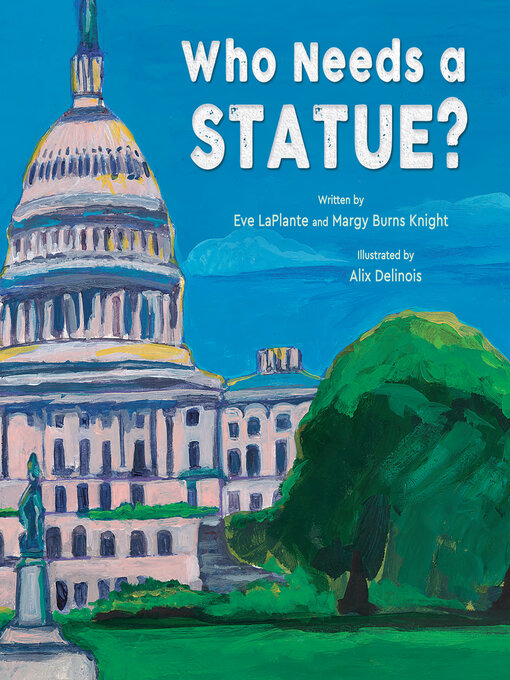This story examines some of the women and BIPOC figures included at the Capitol—and featured in statues around the country—as well as examines the timely question: who needs a statue?
Did you know the U.S. Capitol building features one hundred statues? Each state selects two prominent figures in their history to be included as statues to represent the state in Washington, D.C. But who is chosen to represent this nation? Why are they chosen? And do they really represent this diverse and multifaceted country?-
Creators
-
Publisher
-
Release date
October 15, 2024 -
Formats
-
Kindle Book
-
OverDrive Read
- ISBN: 9781668945896
-
-
Languages
- English
-
Reviews
-
Kirkus
August 15, 2024
A gallery of intrepid American groundbreakers, pathfinders, and activists who have earned commemorative statues. Starting at the U.S. Capitol and ranging as far afield as an airport in Austin, Texas, and a park in Napa, California, the book covers more than a dozen figures--all either women, people of color, or both--who have been immortalized in stone or bronze. Many of the names will likely be unfamiliar to young readers. Beginning with Thocmetony Sarah Winnemucca, the first published Native American woman author, and continuing on past the inspirational likes of Anne Hutchinson (who was banished from colonial Massachusetts for illegally teaching men), comet discoverer Maria Mitchell, and Olympians and activists Tommie Smith and John Carlos, each entry features a brief but sonorous initial annotation and a more detailed one in the backmatter that identifies the statues' sculptors. Delinois' painterly images don't always capture the individual style or character of the monuments the way photos would have, but he does take advantage of his medium to add homey or historical flourishes, such as a view of Deborah Sampson--who dressed in men's clothes in order to fight in the American Revolution--blasting away at a group of redcoats and an image of a child in a wheelchair seated next to a chatty effigy of Everglades advocate Marjory Stoneman Douglas in a garden near Miami. An oblique closing reference to commemorative statues being removed or replaced in many localities ends this powerful recitation on a cogent note. Deserving but less prominent luminaries shine more brightly here.(Informational picture book. 7-10)COPYRIGHT(2024) Kirkus Reviews, ALL RIGHTS RESERVED.
-
Publisher's Weekly
September 23, 2024
Whose accomplishments are commemorated in a public place, for all to see? Of the 100 statutes that stand in the U.S. Capitol Building in Washington, D.C., contextualizing text notes, nine represent people of color and 12 represent women. After offering brief biographies of a few (Paiute writer Thocmetony Sarah Winnemucca and Montana politician Jeannette Rankin, among others), LaPlante, making a children’s book debut, and Knight (Africa Is Not a Country) introduce sculptures across the country that immortalize people of color and women. A statue at San Jose State University honors sprinters Tommie Smith and John Carlos, who stood on the 1968 Olympic winners’ podium “without shoes as a symbol of poverty” and wearing “beads and scarves around their necks in memory of lynching victims.” A statue in Chicago’s Ping Tom Park represents Judge Laura Cha-Yu Liu, who in 2012 became the first Chinese American elected to public office in Chicago. Thickly stroked paintings by Delinois (Greetings, Leroy) show scenes from the subjects’ lives as well as the statues in their settings, in a reportorial work that opens conversations about public representation. Short biographies of those discussed in the text conclude. Ages 7–10. -
Booklist
Starred review from November 1, 2024
Grades 1-4 *Starred Review* Every state honors two local, historic celebrities through sculptures in the U.S. Capitol building. LaPlante and Knight's innovative work considers the 100 statues currently on view and poses important questions: How many BIPOC individuals are included? How many women? And who should be there? After introducing some of the 9 people of color and 12 women currently represented, the text sets off on a cross-country tour of existing statuary, seeking possible candidates. Artworks depict prominent individuals, such as Congresswoman Barbara Jordan, on view in the Austin, Texas, airport, and labor organizer Cesar Chavez, seen in a park in Napa, California. Other statues highlight locals across the U.S. who deserve greater recognition, including Deborah Sampson, who, disguised as a boy, fought in the Revolutionary War--her statue is found outside the public library in Sharon, Massachusetts. States have had the right to request changes since 2000, resulting in such replacements as Mary McLeod Bethune (Florida) and Helen Keller (Mississippi). Expressive illustrations captured with a dynamic color palette portray kids posing next to sculptures, imitating poses, or seemingly engaged in conversation, adding immediacy to the bronze and marble works. Ample back matter provides additional biographical information. This inclusive and fresh approach to communities will pep up local history collections.COPYRIGHT(2024) Booklist, ALL RIGHTS RESERVED.
-
Languages
- English
Loading
Why is availability limited?
×Availability can change throughout the month based on the library's budget. You can still place a hold on the title, and your hold will be automatically filled as soon as the title is available again.
The Kindle Book format for this title is not supported on:
×- - Kindle 1
- - Kindle 2
- - Kindle DX
- - Kindle Keyboard
- - Kindle 4
- - Kindle Touch
- - Kindle 5
- - Kindle Paperwhite
- - Kindle 7
- - Kindle Voyage
Read-along ebook
×The OverDrive Read format of this ebook has professional narration that plays while you read in your browser. Learn more here.



